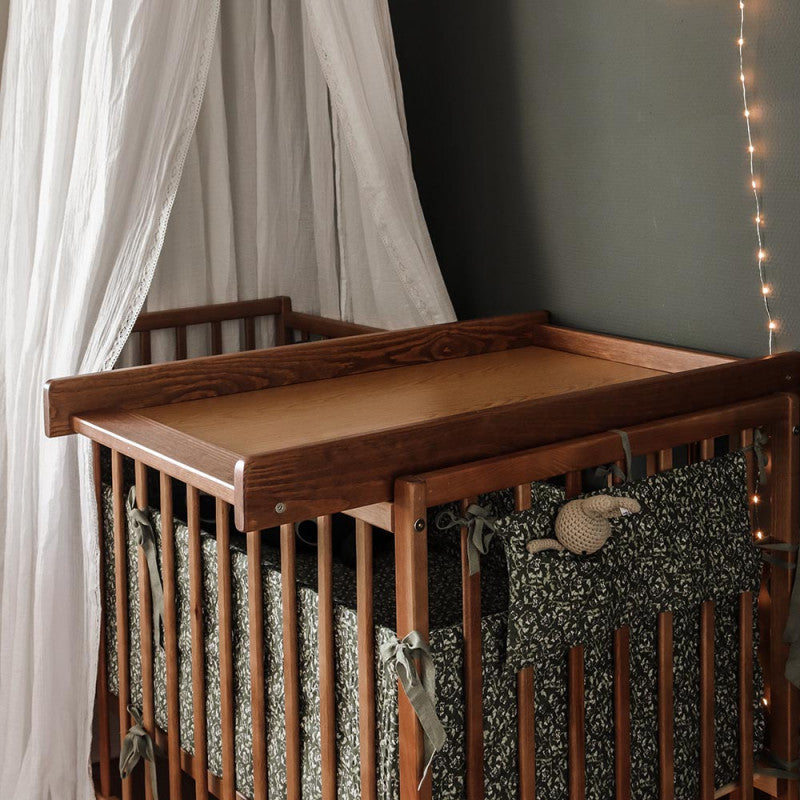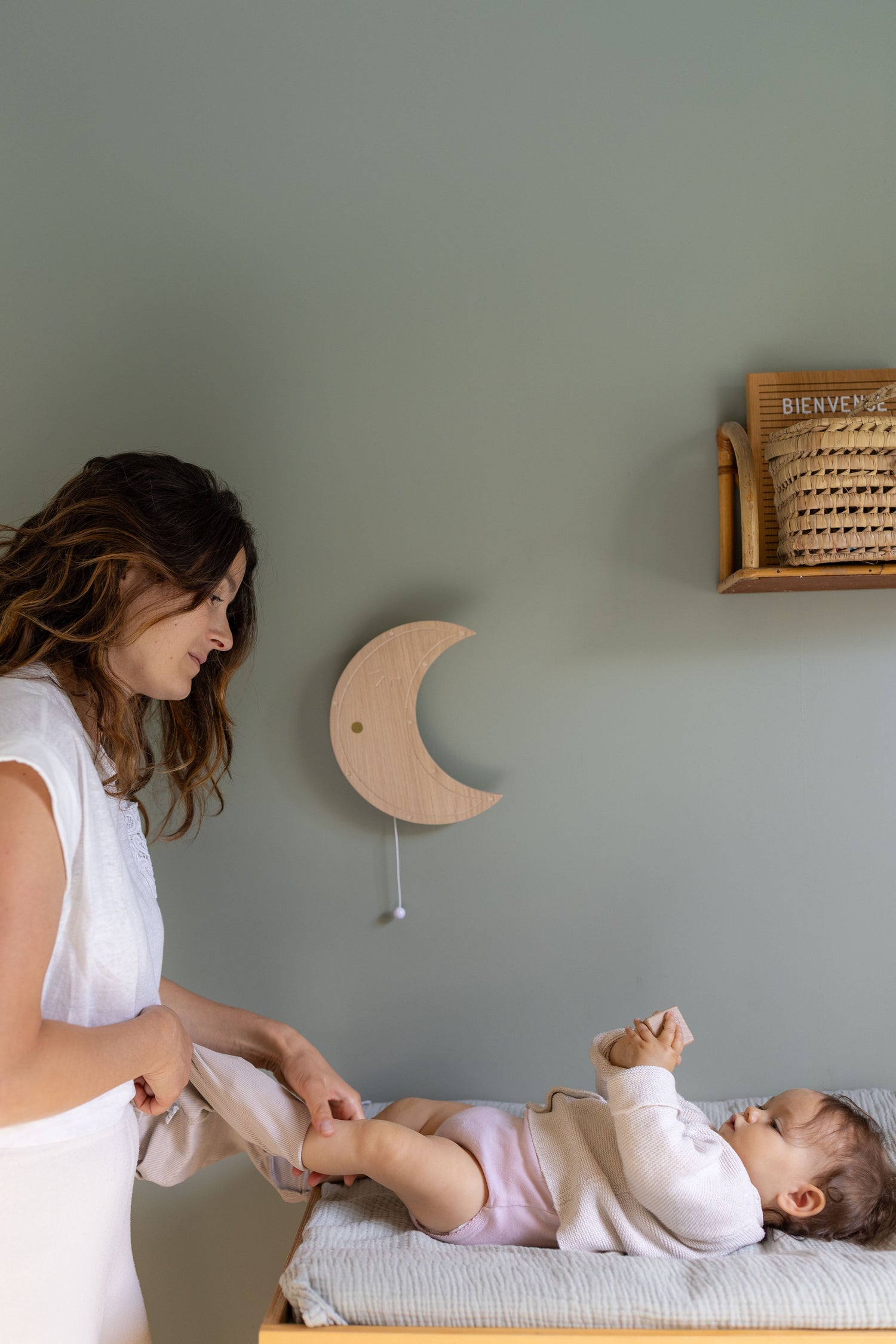
Baby changing table: the clever solution for changing baby
When it comes to preparing for the arrival of a baby , mothers often wonder which changing device to choose. The baby changing table is a clever alternative to the changing table. Less bulky, it adapts to different surfaces and saves space for changing mats.
In this article, we explain why the changing table is an excellent option , especially for small spaces , and how to integrate it into your daily life in an efficient and economical way.
Why choose a changing table for a baby dresser?
One of the main advantages of a baby dresser changing table is its practicality . It allows you to transform a simple dresser into a safe changing area for your child. In addition, unlike a changing table, which can be bulky, a baby changing table adapts to your existing furniture , thus saving space for changing mats.

An economical option for young parents
Buying a changing table can be an additional cost for new parents. The baby changing table or baby changing device is often more affordable, as it avoids investing in an additional piece of furniture . Another significant advantage is that it can be easily moved, allowing you to use it wherever you need it.
Changing table: practical and modular
If you are short on space or want to avoid buying a bulky changing table, a changing table is an ideal solution. It sits directly on a dresser or other flat surface, creating a safe space for changing your baby. In addition to being modular, a changing table allows you to use the furniture already in your baby's room, while optimizing the space. Some changing tables can be placed directly on the crib in your baby's room.
Our tips for installing a changing table in the baby's room:
To optimize space and make changing your baby convenient , choose a location close to essential storage. Install the changing table on a chest of drawers or a stable piece of furniture at the right height (between 82 and 87 cm). Attach non-slip pads under the base to ensure its stability. Keep diapers, wipes, and care products within reach in baskets or drawers nearby.

What size for a changing table?
A standard changing table typically measures between 70 and 85 cm in length and 50 to 55 cm in width. This size will comfortably accommodate a standard changing mat and create a safe space for changing your baby . It is important to check that the changing table fits well on the surface where you want to place it, such as a chest of drawers or a table. If you are looking for a portable model, the dimensions may be slightly smaller to make it easier to transport and store.
The changing table is perfectly suited to small baby rooms.
The major advantage of a changing station is its ability to fit into small spaces.
Unlike a changing table, which often takes up a lot of space, the changing base can be removed and stored away when not in use. This makes it ideal for moms who live in an apartment or are looking to maximize every square foot of the baby's room.
Easy storage
Once baby is changed, the changing station can be easily stored away.
Some models are even foldable, allowing you to slide them under the bed or into a closet. This feature makes them a practical choice for families looking for space-saving changing pad solutions.
Portable changing table for children: a flexible option
For moms who are often on the go or who like to travel with their baby, a portable changing table for children is an essential accessory. This baby changing device folds easily and can be taken anywhere, whether it's for a weekend away, to a friend's house or on holiday. Compact and lightweight, it ensures that you always have a clean and comfortable space to change your baby, wherever you are.

DIY: Make a changing table in 6 simple steps
Materials needed to make your own changing table:
- A wooden board (dimensions: approximately 75 x 55 cm)
- A changing mat
- Wooden cleats (2 of 75 cm and 2 of 55 cm)
- Screws and screwdrivers
- Wood glue
- Paint or varnish (optional)
Step 1: Prepare the board
Choose a smooth wooden board and sand it down to avoid any rough spots. It should be large enough to accommodate the changing mat, but not too bulky to sit on your dresser.
Step 2: Cut the cleats
Take the wooden cleats and cut them into two pairs: one to the length of the board (75 cm) and the other to the width (55 cm). These cleats will be used to frame the changing mat and hold it in place.
Step 3: Attach the cleats to the board
Place the cleats around the edges of the board, aligning them with the dimensions of the mattress. Secure them with wood glue and then screw them in place for added strength. This will create a frame around the changing table.
Step 4: Sand and paint (optional)
If you want to personalize your changing table, sand the edges to soften the corners, then apply a coat of paint or varnish for a clean, attractive finish. Make sure the materials used are safe for baby.
Step 5: Install the changing table
Place the changing table on your dresser or a flat, stable surface. If you want to prevent it from sliding, you can attach non-slip pads to the underside of the board or hooks to anchor it.
Step 6: Add the changing mat
Finally, place the changing mat inside the frame. It must fit snugly so that it does not move during changing.

Baby changing tip: optimize your space.
One of the main concerns of mothers is to optimize the space of the baby's room while maintaining a functional environment. A changing table for a baby dresser is a perfect tip to avoid cluttering the room with a changing table Simply place the changing base on the dresser to create a safe and convenient changing area.

Invest in a modular changing table
For a sustainable investment, choose a modular baby changing table. It can be adjusted according to the age of your child and the space available. Some models even adapt to different furniture heights, so you can be at comfort during changing.

Cyrillus modular changing table, Gustave model
What is the right height for a changing table?
The right height for a changing table is generally between 85 and 95 cm . This allows you to change your baby without having to bend over, thus avoiding back pain for parents. Ideally, the height should correspond to the height of the person who will use it most often. If you are taller or shorter, it may be a good idea to choose an adjustable changing table or to check that the changing surface adapts well to the height of your furniture. The aim is to guarantee maximum comfort during changing.
Organization of the exchange area
Consider organizing your changing area to make it even more convenient. Place diapers, wipes, and creams within easy reach, so you don't have to take your eyes off your baby. A well-placed changing station, coupled with a comfortable changing mat, will make changing a quick and efficient experience for you and a pleasant one for your baby.





